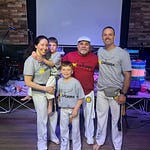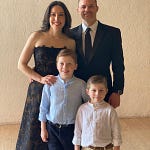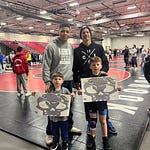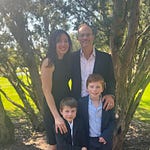🔥Welcome to volume #00071!🔥
I’m Christian Champ. This is ☯️The Middle Way Newsletter ☯️. It is a place where I write, explore, share, and invite you along for the journey.
If you enjoy the newsletter please share it with your friends.
Please follow The Middle Way on Instagram and Twitter.
🏃Running Experiments 🏃
"Yo Dude, I need some milk, please," bellowed my two and half your old son. The request stopped me cold. His words were not what I was expecting.
My curiosity perked up, and his piercing blue eyes stared me down as I paused from typing. He followed up his request with another "YO DUUUUDEEE". There is something about hearing your child yell out "yo dude". It made me chuckle. Life throws us a surprise and we can only pause to enjoy it.
We forget that kids run experiments every single day. In this case, Isaac remixed his brother's comments and directed them towards me. His experiments include mimicking and copying his older brother, Alex.
Watching the experimentation and seeing how he practices and adjusts feels like watching an artist play with clay. He fires off attempts, sees what works, and throws the winning tools and techniques into his toolbox. Kids are masters at running experiments to see what happens next.
They play, practice and perfect the things that draw them in. When they find a task, toy, or topic that interests them and drives their curiosity, they figure it out. They test it, touch it, and take the time to master the activity.
They run experiment after experiment. We all do that too, but we forget we are doing it. We try new restaurants, books, and movies. We play with our schedules and dive into new activities and endeavors.
We always run experiments.
When we run the experiment, we get to see what works. We get to see what we enjoy and want to go deeper on. We set the parameters for what we want to measure and weigh the results.
In the spirit of experimentation and learning, The Middle Way is always running them. A friend of the newsletter, Aaron, a talented visual storyteller and photographer, is currently remixing the newsletter. He takes the ideas from The Middle Way, putting them on Instagram and Twitter.
The goal of the project is like Isaac asking "yo dude" to see how it works. We want to spread the message in other channels and see what resonates.
📓Things to Think About📓
We See We Be by Jamie Wheal
Jamie breaks down the main Ego Stories of the day, so that we can see which ones are pulling us in.
He notes that ultimately what matters the most is if we were playing from love or fear, for all of us or only for some of us. Timeless questions which feel more relevant in the current landscape.
Here's four main Ego Stories that seem to be especially prevalent these days in informing who gets suckered into which particular conspiracy:
The Anti-Establishment Rebel
The Preening Narcissist
The Loyal Foot Soldier
The Guilty Liberal
Which ones resonate and how are we being pushed and pulled by their force?
Are these the only archetypes in play right now? Almost certainly not. Are all of them wrong? Almost certainly not, either. Too soon to tell for most.
Almost no one fits neatly into any of these boxes. Some might, but a bunch more are 60/40 or 80/20 splits, straddling lines and shifting with changes in context and conditions. We're complex people and this world of ours is getting curiouser and curiouser everyday.
But until we identify what parts of our identity we're looking to soothe, validate or empower with the stories we tell... we're going to mistake Truthiness for Truth.
Adrienne Maree Brown on The Darwin Variant and or Love of the Fittest
I joined a call at the Stoa with Adrienne last week which lead me to this piece. She asks how we can better exist in the world and what metaphors can we use to allow that.
Her book Emergent Strategies is highly recommended and offers page after page of things to think about in a world of change.
I now live by these words from my friend Prentis Hemphill, “Boundaries are the distance at which I can love you and me simultaneously.” Love. Not tolerate or survive, but love. When I speak these words, as reminder, as mantra, they give me hope that no one has to be disposable, cut off from that vast connectivity of love. It’s just a matter of distance.
Everyone struggles and our acknowledgment of this enables us to live in the world in a better place and as a better people.
With enough distance, I can love even those who, up close, hate me, or hate the earth, or hate anything different from them. I know “only love can conquer hate.” From far away I can see the haters of the world – those who hate nature, difference, complexity, freedom in others – in the grip of their own spiritual work, which is daunting, which devours from within. Knowing almost nothing of the mysteries of the universe, having only our own planet’s wisdom to learn from, I deduce that even the haters are processing something for the whole, though it may be something toxic, or something heading towards extinction.
Ultimately this is where we want to end up.
I can only be vulnerable, I can only live into my own values, I can only invite others to join me, and to teach me.
Sasha Dichter on Awesome Hiring, Awesome Team
Here is how he buckets the key traits on the list of twenty traits that lead to a good hire. We all know the power of working with extraordinary teammates. How they Lebron James it and make everyone around them better and the team better.
Here is how Sasha broke out the 20 traits into five key buckets.
As I spent time with these 20 traits, I found myself bucketing them into five categories:
Flexible, moves fast, avoids bureaucracy: 1, 11, 17
Takes initiative, is curious, is always trying to make things better: 7, 8, 9, 13, 16, 19
Empathetic, values diversity, is humble, communicates & connects with others: 2, 3, 4, 5, 6
Keeps an eye on the big picture: 10, 12, 20
Is self-aware: 14, 15, 18
🎧Things to Listen, See, and Watch 🎧
On Being Podcast (Krista Tippet) with Suzzane Simard - Forests are Wired for Wisdom (Listen and Transcript)
Simard:
Yes. Social systems, human social systems — you know, ecosystems, they’re built fundamentally in similar ways. They’re what scientists are now calling complex adaptive systems. And that complexity has a pattern, and that pattern is highly evolved. And then how that system works, like through these networks, whether you’re in a human social network or a fungal network in the forest, it’s evolved to, basically, to propagate species, [laughs] which I don’t disagree with Darwinianism in that way, in that, yes, species want to survive and reproduce, but the way they do it is much more sophisticated than we’ve thought about or that we’ve developed our science based on. But even now, it’s becoming more mainstream, known, that endosymbiosis has been highly important in collaboration and cooperation.
Tippett:
That was — I think — was that the term that Lynn Margulis initially coined — the endosymbiosis? So describe what that is.
Simard:
Yeah, so that’s — in the evolution of eukaryotic cells — and prokaryotic cells, as well — what we’ve discovered now, or scientists have discovered, is that it really — that evolution involved the engulfing of one organism of another, and that led to the development of organelles like mitochondria. Now we know that it’s not just the evolution of a species by itself. And so that endosymbiosis means it’s a symbiosis. They live together, that’s what symbiosis means. “Endo-” means, like, the engulfing and creating the eukaryotic cell with a nucleus and ribosomes and all the other organelles that are really an evolution of this collaboration, this cooperation, and even in the human genome, as we’ve discovered that, that we are full of DNA that is from other organisms — viruses and bacteria, and … So now it’s actually accepted that this is, you know, this has been fundamental to evolution. But it did take a long time, and I think Lynn Margulis took a lot of heat [laughs] for her ideas.
Simard:
It is. You know, I’ve had such great fortune to, in the last decade, to work with Aboriginal scientists and Aboriginal people. I got a postdoc, Dr. Teresa Ryan, who is a salmon fishery scientist, and I’d been struggling so much in this Western science sphere, with my colleagues and publishing my work and fighting to get the interpretations accepted of collaboration and wholeness of the ecosystems. And I just started talking to her, and she’s like, “Well, our worldview is that we are part of these ecosystems; that we are all connected together, we can’t be separated from each other, and that yeah, collaboration is all part of it; that the world is an entwined place.” And she even showed me this oral history and writings by a man, subiyay, Bruce Miller of the Skokomish Nation, and he had written about these fungal networks in the soil — and that was before these discoveries — and how his people had known about these networks and how it kept the forest strong for millennia. And I’m like, oh my God, we’ve been so narrowly focused on reductionist science, pulling things apart and then trying to understand them, that we lost our way to actually see these as whole systems.
Tippet: I just want to read something you wrote, just this incredible passage from your book:“We can think of an ecosystem of wolves, caribou, trees and fungi creating biodiversity just as an orchestra of woodwind, brass, percussion and string musicians assemble into a symphony. Or how our brains, composed of neurons, axons and neurotransmitters, produce thought and compassion. Or the way brothers and sisters join to overcome a trauma like illness or death — the whole greater than the sum of the parts.”
Great questions from @_ali_taylor and @sbkaufman

Jason Silva on the Demons We All Battle
We make our way in the world doing our best to “fit in”, “appear normal”, play the role we’ve been given… all the while brooding with doubt and fear and ocasional resignation. We have hopes and dreams and disappointments. We face confusion and alienation. We don’t feel safe. Everyone you meet is fighting a battle we know nothing about. We must be compassionate.
Deion Sanders on What They Practice by Dr. Micheal Gervais’ Instagram feed
This is not just for athletes. This is for everyone.
Ask yourself…
Not only “What am I practicing?” But “HOW am I practicing?”
We are always practicing, something.
Everything we do and think and say, is practice.
What we practice becomes familiar.
We don’t rise to occasions, we fall to the level of our training.
And when we’re clear about why we
💣Words of Wisdom💣
Krista Tippet - Becoming Wise
We create transformative, resilient new realities by becoming transformed, resilient people. This is about the lover as well as the beloved, the citizen as well as the politician, the social entrepreneur as well as the person in need. It means me, and it means you.
Krista Tippett - Becoming Wise
I've come to think of virtues and rituals as spiritual technologies for being our best selves in flesh and blood, time and space.
Thich Nhat Hanh - No Mud, No Lotus
Mindfulness is always mindfulness of something. It’s the energy that helps us be aware of what is happening right now and right here, in our body, in our feelings, in our perceptions, and around us.
Oliver Burkeman - Four Thousand Weeks
This fact-the fact that there is being, to begin with-is "the brute reality on which all of us ought to be constantly stubbing our toes," in the splendid phrase of the writer Sarah Bakewell. But instead, it almost always passes us by.
Mary Oliver - Upstream
The working, concentrating artist is an adult who refuses interruption from himself, who remains absorbed and energized in and by the work—who is thus responsible to the work.
🙏Thanks for reading🙏
What experiments are you running? What experiments do you need to run?
Any thoughts or comments, please share!
Namaste,
Christian
















